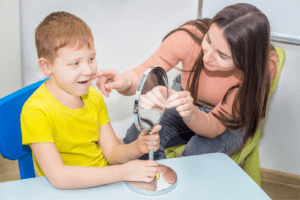What the CDC Now Says About Speech-Language Milestones
In February of 2022, the CDC released an update of expected skills for speech and language development. This update lowered developmental milestones with no involvement or consultation from speech-language pathologists. The new milestones released by the CDC will likely result in a decrease of early identification and early intervention. Additionally, children may later be affected by the reduction of developmental expectations, as academic expectations in preschool and elementary school have simultaneously increased.

Milestones: A Guide To Support
It is important to express that milestones are not everything; however, they are provided as a guide to support families, physicians, and other professionals in monitoring any potential delays in speech and language development. They also help to provide guidance for when to see a speech-language pathologist, who can then do a comprehensive evaluation to determine if therapy services are warranted. Our speech therapy team wants to provide you with information, taken from a criterion referenced instrument, to adequately monitor your child’s speech and language milestones.
9 MONTHS
According to the CDC:
- – Makes different sounds like “mamama” and “babababa”
- – Lifts arms to be picked up
According to research, a child should also be able to:
- – Shout or vocalize to gain attention
- – Sing along with a familiar song
- – Say “mama” or “dada” meaningfully
- – Say one or two words spontaneously
12 MONTHS
According to the CDC:
- – Waves “bye bye”
- – Calls a parent “mama” or “dada’ or another special name
- – Understands “no”
According to research, a child should also be able to:
- – Give objects when asked to
- – Look at common and familiar objects and people when named
- – Follow simple, routine-based one-step directions occasionally (e.g. pick up the ball)
- – Point to two body parts on self
15 MONTHS
According to the CDC:
- – Tries to say one or two words besides “mama” or “dada,” like “ba” for ball or “da” for dog
- – Looks at a familiar object when you name it
- – Follows directions given with both a gesture and words. For example, he gives you a toy when you hold out your hand and say, “Give me the toy.”
- – Points to ask for something or to get help
According to research, a child should also be able to:
- – Say or imitate 8-10 words spontaneously
- – Point to common action words in pictures (e.g. eating, sleeping, swinging)
- – Understand some basic prepositions (e.g., on, in)
- – Point to three body parts on self or doll/toy
18 MONTHS
According to the CDC:
- – Tries to say three or more words besides “mama” or “dada”
- – Follows one-step directions without any gestures, like giving you the toy when you say, “Give it to me.”
According to research, a child should also be able to:
- – Say at least 15 meaningful words
- – Show emerging word combinations/imitate two-three word phrases (e.g. mommy eat, me go)
- – Complete two requests with one object (e.g. kick ball and throw ball)
- – Point to six body parts on self or doll/toy
24 MONTHS
According to the CDC:
- – Points to two body parts
- – Points to things in a book when you ask such as, “Where is the dog?”
- – Uses gestures such as blowing a kiss and nodding yes
- – Says at least two words together like “more milk”
According to research, a child should also be able to:
- – Use 50 different words
- – Use two-word phrases frequently
- – Uses three-word phrases occasionally
- – Use early pronouns occasionally (e.g., I, me)
2.5 YEARS (30 MONTHS)
According to the CDC:
- – Says about 50 words
- – Says two or more words, with one action word, like “Doggie run”
- – Names things in a book when you point and ask, “What is this?”
- – Says words like “I,” “me,” or “we”
According to research, a child should also be able to:
- – Use three and four-word phrases (e.g., “I need help”)
- – Follow two-step unrelated commands
- – Understand concept of “one” (e.g., “Give me one ball”) and “all” (e.g., “Give me all the cars”)

Takeaways:
Understanding how and when your child’s speech and language skills should develop is extremely helpful for knowing when to potentially seek extra support from a speech-language pathologist. Unfortunately, the new CDC guideline expectations do not take into account previously studied research or the expertise of speech-language pathologists; therefore, these guidelines should be followed with caution.
Our advice? Consult with a speech-language pathologist who follows data-driven norms on speech milestones. Look at our Speech Therapy Webpage and/or give us a call at 773-687-9241 to set up a consultation with a pediatric physical therapist today!
Have an older, school age child? Check out our Therapeutic Children’s Academy and see how we can help your entire family reach their maximum potential


